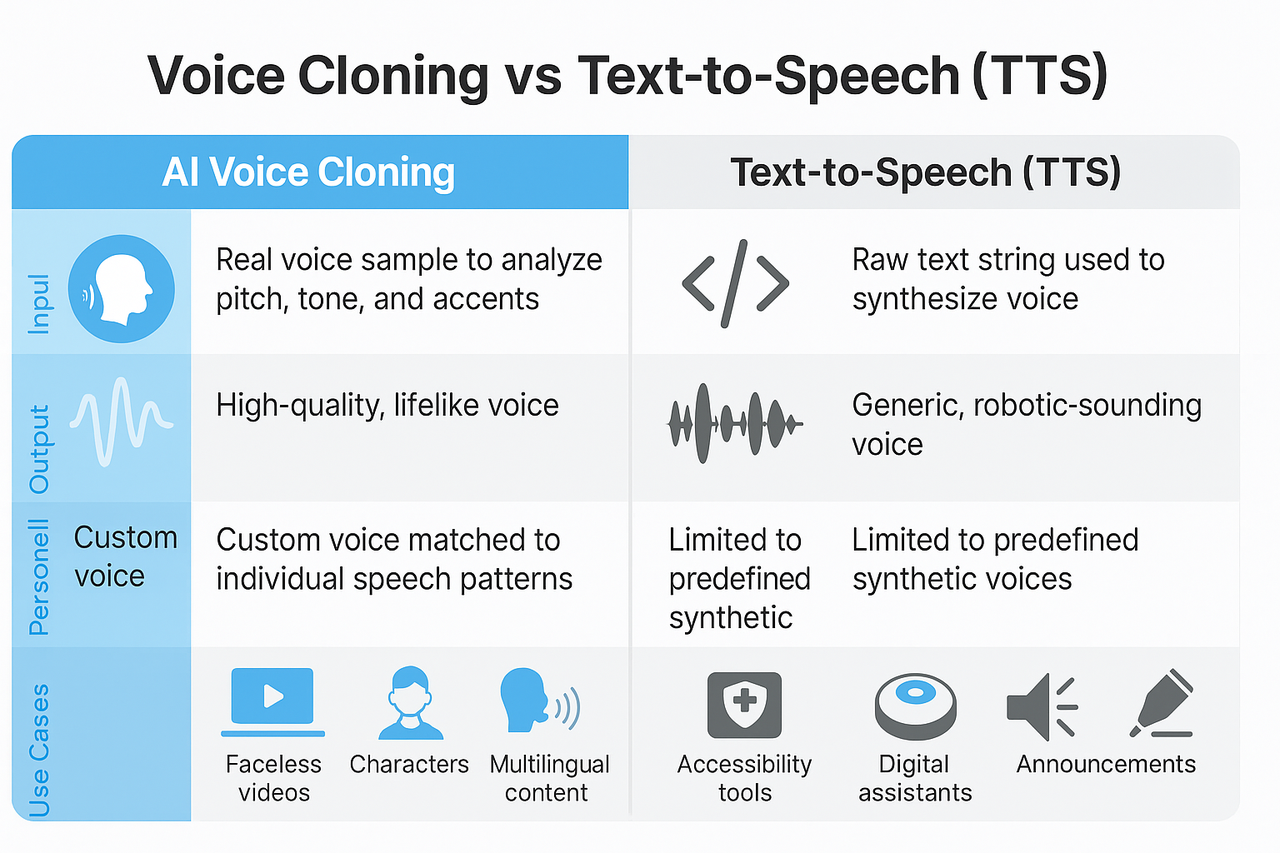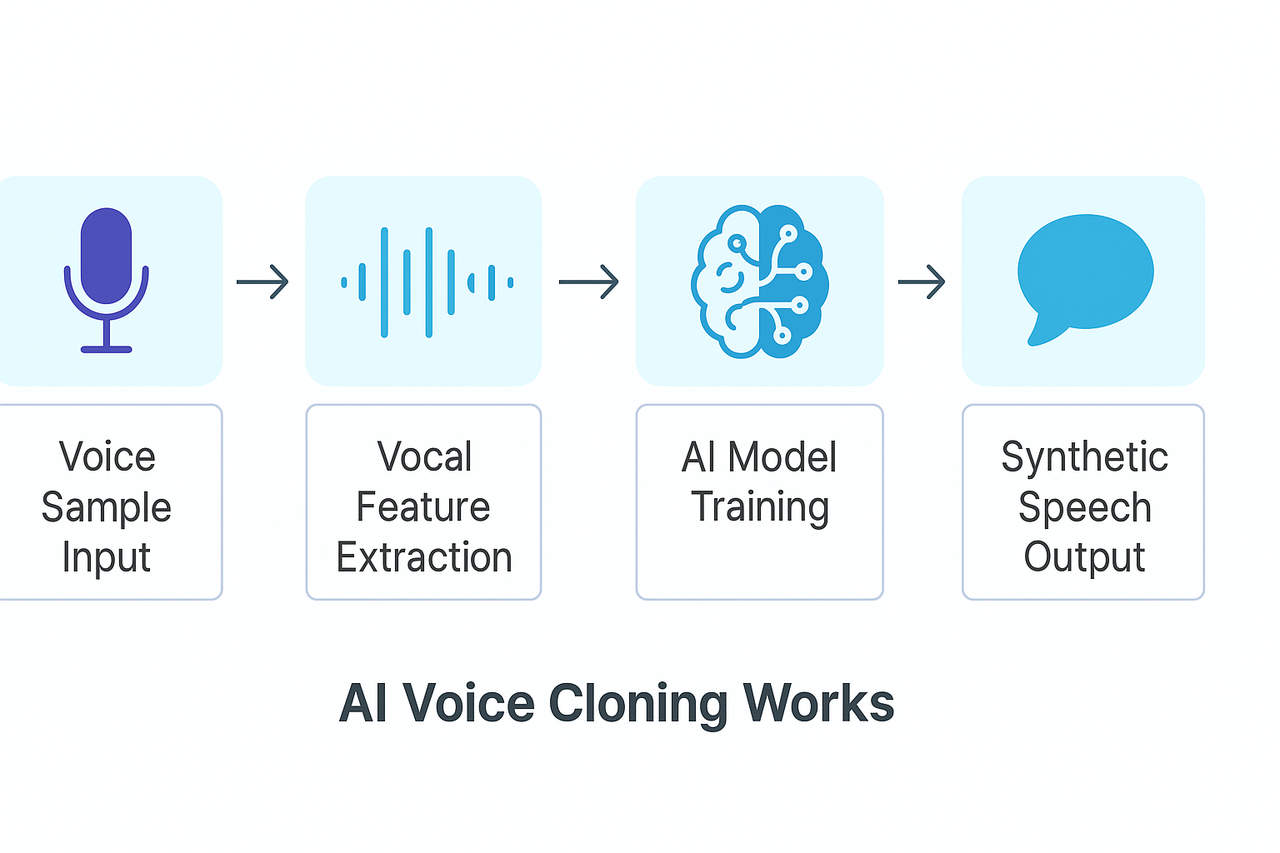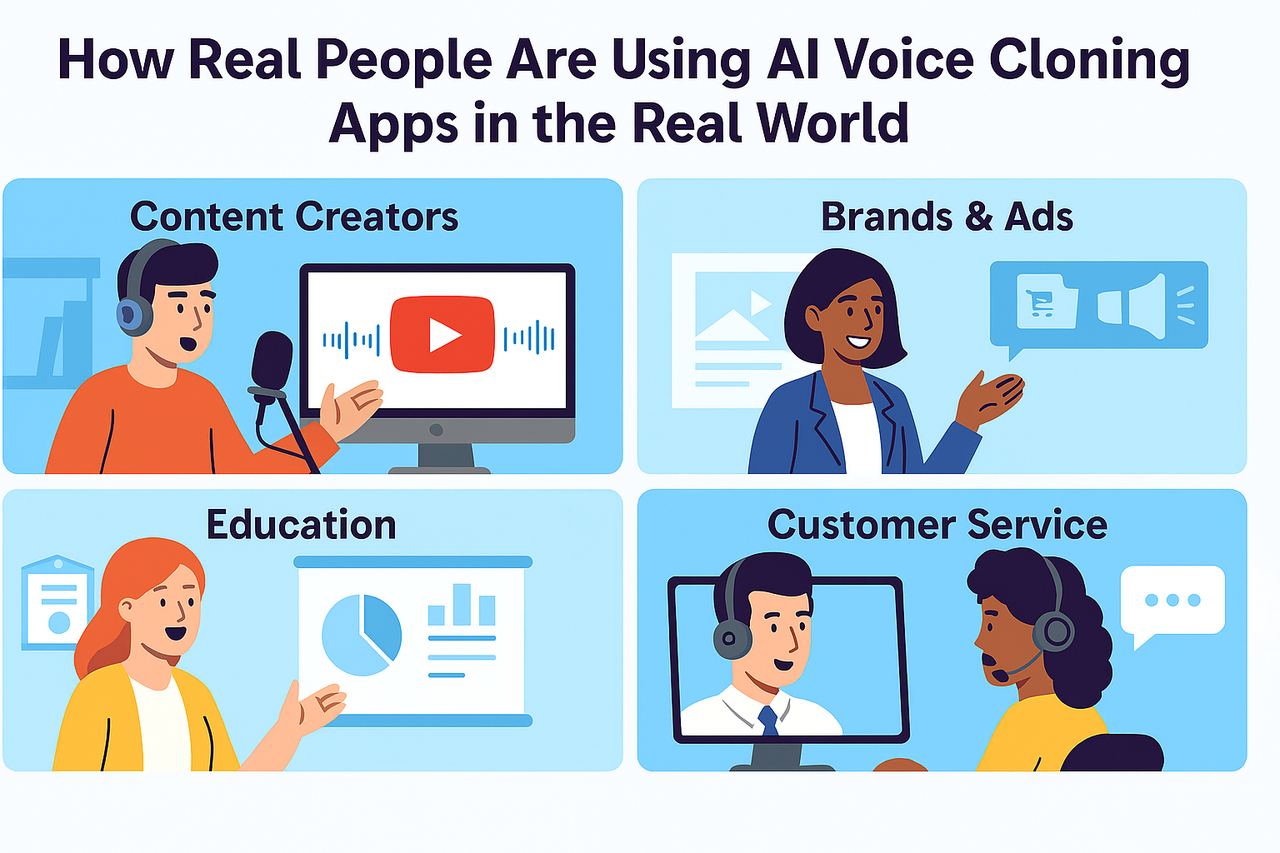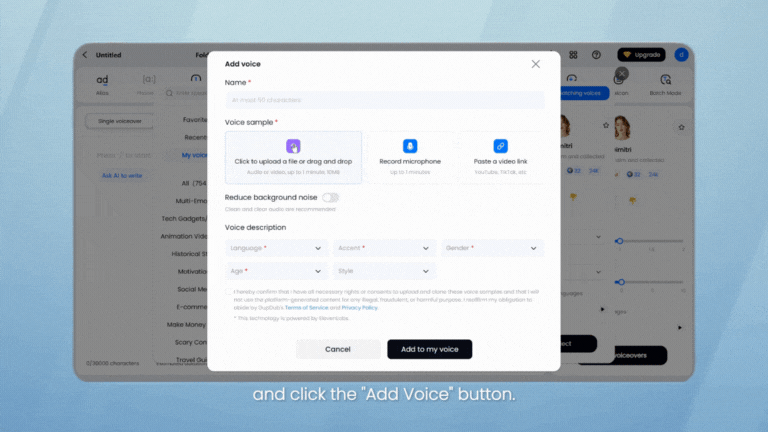TL;DR
AI voice cloning is the process of replicating a human voice using artificial intelligence. It starts with a short voice sample, analyzes unique vocal traits like pitch and rhythm, and builds a model to generate synthetic speech that sounds just like the original speaker.
Unlike traditional text-to-speech (TTS), voice cloning offers a personalized voice that can speak any input text—making it a powerful tool for creators, educators, brands, and developers.
This guide walks you through how it works, how it's different from standard TTS, real-world use cases, and how to try it for yourself using DupDub, a leading voice cloning platform.
Ready to bring your voice to life? Let’s get started.
Introduction
So, how does this cool technology work? And how can everyday people—like students, teachers, or video creators—actually use it?
This blog will explain AI voice cloning in simple terms: what it is, how it works, and how you can try it using DupDub, a tool that lets you create your own digital voice in just a few steps. If you're curious about how computers can sound like real people—or even like you—this article is for you!
What Is AI Voice Cloning?
AI voice cloning is a powerful technology that creates a digital copy of a real person’s voice. Using machine learning, it can analyze a short voice sample—as little as 30 seconds—to learn key traits like pitch, tone, accent, and rhythm. The result? A synthetic voice that can speak any text in a way that sounds almost identical to the original speaker.
This process is significantly different from traditional text-to-speech (TTS) systems. While TTS tools use generic, robotic-sounding voices, voice cloning replicates your own voice (or any target voice) with realistic intonation and emotion. As noted in a recent peer-reviewed review:
Voice cloning is useful for a wide range of applications—from faceless YouTube videos and podcast narration to game characters and multilingual e-learning modules. It allows creators to produce human-sounding, scalable audio content without recording every sentence manually.
How AI Voice Cloning Works
AI voice cloning may sound like science fiction, but under the hood, it's a well-orchestrated combination of deep learning and speech synthesis technologies. Here’s a breakdown of the typical workflow in four simple steps:
Voice Sample Collection
The process begins with a short voice recording (usually 30 seconds to a few minutes). This sample captures the speaker's unique vocal traits, including pitch, tone, cadence, and accent.
Feature Extraction
The AI analyzes the voice sample to extract acoustic features. These include things like phoneme structure, frequency patterns, and vocal energy.
Model Training
Using deep neural networks (such as encoder-decoder or diffusion-based models), the system learns to replicate the speaker’s voice. These models are trained on large speech datasets to understand how to reproduce speech patterns.
Speech Generation
Finally, the AI can generate new speech based on text input, using the trained voice model. The output is a lifelike, personalized voice that mimics the original speaker.
Voice Cloning vs TTS: What’s the Difference?
Although AI voice cloning and text-to-speech (TTS) may sound similar, they are fundamentally different in how they work and what they produce.
Text-to-Speech (TTS) systems generate synthetic speech from text using pre-built, generic voices. These voices are designed to sound clear and consistent, but they often lack emotion and personalization. Most TTS systems cannot mimic your unique vocal style or personality.
AI Voice Cloning, on the other hand, creates a digital replica of a specific person’s voice. It learns how a person speaks and reproduces their unique tone, cadence, and inflection. This makes voice cloning ideal for personalized applications like:
-
YouTube narration with your own voice
-
Custom voiceovers in games or animations
-
Multilingual content with consistent brand tone
Here’s a quick comparison:
| Feature |
Text-to-Speech (TTS) |
AI Voice Cloning |
| Voice Type |
Generic |
Personalized |
| Input Required |
Just text |
Text + voice sample |
| Emotional Range |
Limited |
High |
| Use Case Fit |
General narration |
Branding, creator content |
| Output Sound |
Robotic |
Human-like |
How Real People Are Using AI Voice Cloning Apps in the Real World
AI voice cloning is no longer just a lab experiment. It’s already transforming how individuals and organizations create, scale, and personalize audio content. Here are some of the most impactful ways it’s being used today:
YouTube Creators & Podcasters
Voice cloning allows content creators to narrate videos or episodes in their own voice without needing to record each line. This is ideal for faceless YouTube channels, automated video series, or creators working in multiple languages.
For example, some creators use platforms like
DupDub to generate consistent voiceovers for YouTube Shorts, saving hours of recording time while maintaining a human sound.
Marketing Teams & Brand Voice
Brands can train AI models on their spokesperson’s voice to keep messaging consistent across video ads, social media, or customer onboarding tutorials. This ensures brand tone and identity are preserved—even in localized or repurposed content.
E-Learning & Education
Educators can use voice cloning to produce course materials, tutorials, and quizzes in multiple voices or languages. This is especially helpful in K–12 or adult education, where varied voices can aid comprehension and engagement.
Customer Service & Assistive Tech
Some companies are using cloned voices in IVR systems or chatbots to offer a more friendly, human-like experience. Others are exploring voice cloning to help users with speech disabilities regain a version of their original voice.
How to Try AI Voice Cloning with DupDub
You don’t need to be a developer or audio engineer to try voice cloning today. With tools like DupDub, the process is accessible, fast, and even fun. Here’s how you can get started in just a few minutes:
-
Create a Free Account
Sign up at
DupDub and choose a plan (you can start free with limited voice cloning credits).
-
Upload Your Voice Sample
Record or upload a short clip (at least 30 seconds) of your voice. Make sure it’s clear, without background noise.
-
Let DupDub Train Your Voice
DupDub uses advanced AI to analyze your voice and create a unique vocal model. This may take a few minutes depending on length and quality.
-
Start Typing and Listening
Once your voice is ready, type anything into the text box—and hear it spoken back in your voice. You can preview it, export it, or use it in videos, presentations, and more.
Many creators use this to produce entire faceless videos or automate multilingual narration while keeping a consistent voice identity.
Whether you’re experimenting or ready to scale content production, DupDub makes professional-grade voice cloning available to everyone.
Future of Voice Cloning
Voice cloning is getting better and smarter every year. In the future, it will do much more than just read text out loud. Thanks to new AI technology, these voices will sound more natural, expressive, and can even speak different languages.
Real-Time Voice Cloning
Soon, you’ll be able to hear a computer copy a voice almost instantly—even during a live stream or video call. This could help people from different countries talk to each other in real time.
Voices That Speak Different Languages and Emotions
New voice cloning tools will let one voice speak in many languages, while also sounding happy, sad, excited, or calm—just like a real person.
Talking Avatars and Videos
In the near future, voice cloning will be used with animated avatars to create lifelike video presenters. These digital characters could teach lessons, host shows, or even become virtual influencers.
As the technology grows, voice cloning will become a regular tool for creating videos, teaching online, and helping people understand information in their own language.
FAQs: Voice Cloning in Practice
-
1. Is AI Voice Cloning Legal and Safe to Use?
Yes—as long as you have permission. Using someone’s voice without their consent may violate privacy and publicity rights. Always make sure the speaker has agreed in writing if you plan to use the cloned voice publicly or commercially. Tools like DupDub require users to confirm they have the right to use any voice uploaded.
-
2. How Accurate Is an AI-Generated Voice Clone?
Modern AI voice cloning tools can produce highly accurate results when trained with clear, high-quality audio. Platforms like DupDub replicate not just words, but also natural pitch, intonation, and rhythm. The more voice data you provide, the better the cloned voice sounds.
-
3. Can I Try a Voice Cloning App for Free?
Yes. Many voice cloning apps offer free trials or demo credits. DupDub, for example, allows users to test how their cloned voice sounds before purchasing a plan. This lets you explore how the technology works without commitment.
-
4. What Equipment Do I Need to Use a Voice Cloning Tool?
All you need is a quiet room and a standard-quality microphone. Most AI voice cloning services run entirely in the cloud, so there’s no need for expensive software or hardware.
-
5. Can I Use My Cloned Voice for Commercial Projects?
Yes, as long as the cloned voice is your own or you have documented permission from the original speaker. Most platforms, including DupDub, allow commercial use, but always check licensing terms and follow local laws.







